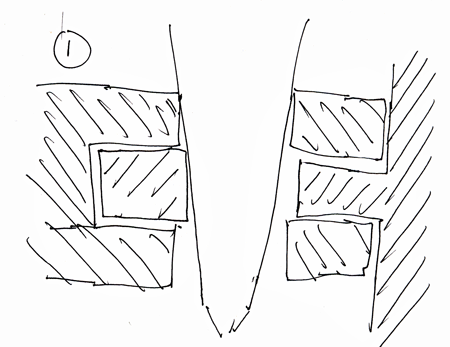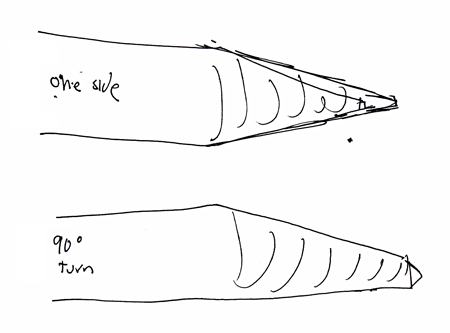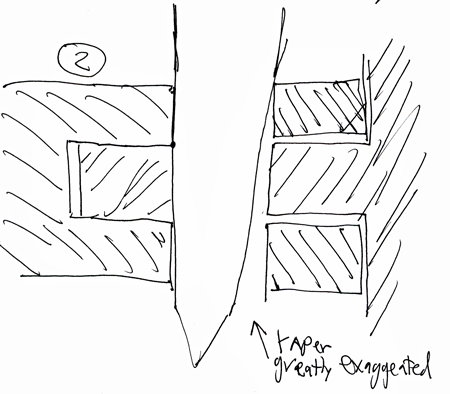 Since we introduced Ray Iles's draw bore pins last fall, we've gotten a ton of questions about why real ones such as these work better than concentric tapered pins - that is, pins that are sometimes misconstrued as draw bore pins but really are just tapered drift pins. Since we introduced Ray Iles's draw bore pins last fall, we've gotten a ton of questions about why real ones such as these work better than concentric tapered pins - that is, pins that are sometimes misconstrued as draw bore pins but really are just tapered drift pins.
Drift pins are just tapered rods, which from any angle look like cones.  Traditional draw bore pins, on the other hand, look like drift pins in one dimension, but if you rotated the pin 90 degrees, one side would becomes straight and the other more tapered. A section of the draw bore pin at any point is a circle, but geometrically the shape is what's known as an "oblique cone." Traditional draw bore pins, on the other hand, look like drift pins in one dimension, but if you rotated the pin 90 degrees, one side would becomes straight and the other more tapered. A section of the draw bore pin at any point is a circle, but geometrically the shape is what's known as an "oblique cone."
Now, why is this shape better? When you put a draw bore pin into a partially assembled mortise, it will contact the joint at some point shown in the first drawing. Where the point of contact would be exactly would depend on the taper, the thickness of the joint, etc., but the pin will engage somewhere. If it engages with the joint with the vertical side of the cone touching the left side of the joint (as the joint is drawn in Fig 1) and isn't symmetrical, turning the draw bore pin and letting it sink down will make it go deeper into the joint. At some point it will be engaged, and then when you turn it, the oblique part of the taper forces the joint tighter. You can actually see this in use. Now you may say, "Well, doesn't a regular pin do this, except you have to pull it towards the joint  to push it out?" That's a good question. And the answer is yes - but not so much. Since you don't know the actual geometry of engagement, it's hard to make sure to tilt to the right degree, neither too much nor too little. The real issue is leverage. There is some mechanical advantage of the fulcrum between where a tapered pin will hit the top of the mortise and the inside of the tenon against the length of the entire drift pin. But with a real draw bore pin, the leverage you get by tuning an oblique cone is significantly greater. So when you use real draw bore pins, you can actually sometimes see joints being pulled together, squishing bits of detritus of the joint out of the way. to push it out?" That's a good question. And the answer is yes - but not so much. Since you don't know the actual geometry of engagement, it's hard to make sure to tilt to the right degree, neither too much nor too little. The real issue is leverage. There is some mechanical advantage of the fulcrum between where a tapered pin will hit the top of the mortise and the inside of the tenon against the length of the entire drift pin. But with a real draw bore pin, the leverage you get by tuning an oblique cone is significantly greater. So when you use real draw bore pins, you can actually sometimes see joints being pulled together, squishing bits of detritus of the joint out of the way.
Draw bore pins are also hardened so they don't bend and have welded bolsters for added strength.
In the old days, their common use was in doors, although they make pulling any M+T joint together easier. It's also easy to use them for test-fitting joints. A critical use for them was on wooden buildings,to align beams and pull wooden joints together. To this day, a modern version of a draw bore pin with even more offset is used on steel structures to pull steel beams into alignment. (Our product description of the draw bore pins shows an example of this). They work better on hardwood; with very soft woods, there is so much force in turning the pin you can distort the hole in the tenon.
|
 Joel's Blog
Joel's Blog Built-It Blog
Built-It Blog Video Roundup
Video Roundup Classes & Events
Classes & Events Work Magazine
Work Magazine


 Since we introduced
Since we introduced  Traditional draw bore pins, on the other hand, look like drift pins in one dimension, but if you rotated the pin 90 degrees, one side would becomes straight and the other more tapered. A section of the draw bore pin at any point is a circle, but geometrically the shape is what's known as an "oblique cone."
Traditional draw bore pins, on the other hand, look like drift pins in one dimension, but if you rotated the pin 90 degrees, one side would becomes straight and the other more tapered. A section of the draw bore pin at any point is a circle, but geometrically the shape is what's known as an "oblique cone." to push it out?" That's a good question. And the answer is yes - but not so much. Since you don't know the actual geometry of engagement, it's hard to make sure to tilt to the right degree, neither too much nor too little. The real issue is leverage. There is some mechanical advantage of the fulcrum between where a tapered pin will hit the top of the mortise and the inside of the tenon against the length of the entire drift pin. But with a real draw bore pin, the leverage you get by tuning an oblique cone is significantly greater. So when you use real draw bore pins, you can actually sometimes see joints being pulled together, squishing bits of detritus of the joint out of the way.
to push it out?" That's a good question. And the answer is yes - but not so much. Since you don't know the actual geometry of engagement, it's hard to make sure to tilt to the right degree, neither too much nor too little. The real issue is leverage. There is some mechanical advantage of the fulcrum between where a tapered pin will hit the top of the mortise and the inside of the tenon against the length of the entire drift pin. But with a real draw bore pin, the leverage you get by tuning an oblique cone is significantly greater. So when you use real draw bore pins, you can actually sometimes see joints being pulled together, squishing bits of detritus of the joint out of the way.
Cheers ;-)
Paul Chapman
The handles and tops were never beat up which shows they were not used by striking.
I also have several antique catalogs where the offset, which small is drawn in and the engraving is not symmetric.
And of course you can buy once for steel work today.
And of course when working on site or on anything large regular bar clamps are awkward to use by comparison and drift pins don't stay put if you let go and distort the holes. With proper drawbore pins you can twist them in the holes, without pulling them in any directions, they visibly tighten up the joint with a lot of pressure and will keep the pressure up until turned loose.
I don't really think there is much doubt on the design here.